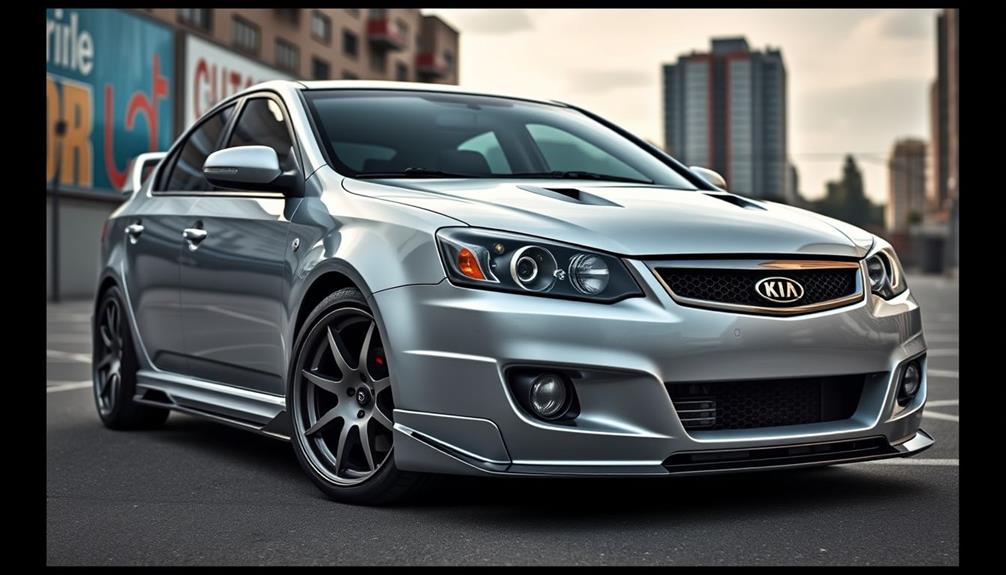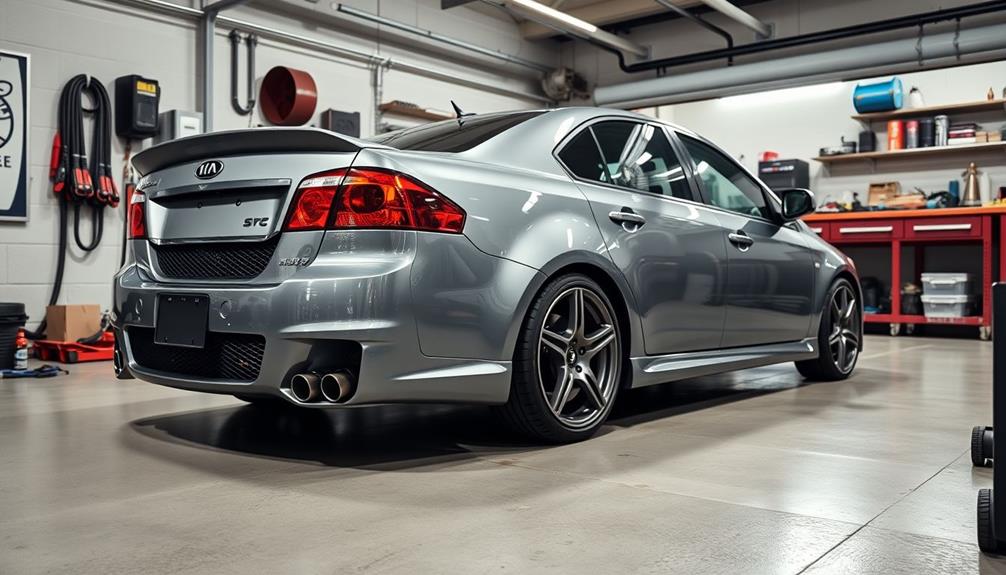Tuning your 2008 Kia Spectra can bring modern power to your compact sedan. Start by upgrading the cold air intake for better airflow and consider larger throttle bodies and fuel injectors for a noticeable horsepower boost. Don't overlook your exhaust system; a cat-back exhaust enhances airflow and sound. Just remember, proper tuning is essential to keep everything running smoothly. Regular maintenance, like timing belt checks and fluid changes, also plays a key role in performance longevity. There's plenty more to explore about options and tips tailored for your Spectra's potential, so stick around to discover even more insights.
Key Takeaways
- Upgrading to cold air intakes and exhaust systems improves airflow, enhancing performance and sound for the 2008 Kia Spectra.
- Larger throttle bodies and fuel injectors boost horsepower but require proper tuning for optimal performance.
- Regular timing belt maintenance is crucial to prevent engine damage and ensure reliability after performance modifications.
- Choosing between manual and automatic transmission impacts driving dynamics and maintenance needs for a tuned Kia Spectra.
- Engaging with enthusiast forums provides valuable insights and support for aftermarket modifications to enhance your vehicle.
Performance Modifications Overview
When it comes to tuning your 2008 Kia Spectra, you've got several performance modifications to contemplate. One popular option is to install cold air intakes (CAIs). While they can improve airflow to your engine, be prepared for some excessive noise, as the sound can be more pronounced than you might expect.
Despite this, the performance boost may not be as significant as you'd hope.
If you're looking for more horsepower, consider upgrading to larger throttle bodies and fuel injectors. These changes can enhance your engine's output, but proper tuning is essential to avoid potential engine problems.
You might also want to look into tuned headers and exhaust systems. These modifications provide better airflow and a more aggressive sound compared to stock components, maximizing your horsepower gains.
Keep in mind that aftermarket support for the Spectra is somewhat limited, but you can find performance kits from shared models, like the Hyundai Tiburon, to expand your options.
Regular maintenance, such as replacing your timing belt every five years or 60,000 miles, is also vital for maintaining your engine's performance and longevity.
Engine Specifications Insights

The 2008 Kia Spectra's 2.0L inline-4 engine delivers a reliable 138 horsepower at 6000 RPM, making it a solid choice for everyday driving. This engine's four-cylinder configuration not only provides adequate power but also guarantees competitive fuel efficiency ratings of 23 MPG in the city and 30 MPG on the highway.
If you're budget-conscious, you'll appreciate the durability and reliability of this engine, which is designed to withstand the rigors of daily use.
However, it's essential to keep up with maintenance to maximize the engine's performance. The Spectra's engine is an interference type, so regular timing belt replacements every 5 years or 60,000 miles are a must to prevent potential damage.
Standard maintenance tasks also include regular oil changes and transmission fluid replacements, with the latter recommended every 30,000 miles.
Additionally, the engine pairs seamlessly with the vehicle's four-speed automatic transmission, providing a smooth driving experience.
Exhaust System Upgrades

Upgrading the exhaust system of your 2008 Kia Spectra can greatly enhance its performance and sound.
By focusing on the right modifications, you'll not only enjoy an aggressive tone but also experience notable horsepower gains and performance improvements.
Here are some key upgrades to take into account:
- Tuned Headers or Exhaust Manifolds: These components can provide significant horsepower gains by maximizing exhaust flow and enhancing sound quality.
- Cat-Back Exhaust System: This upgrade improves airflow, guaranteeing your engine breathes better, which translates to enhanced overall performance.
- Remove Rear Cat and Resonator: While this can lead to a bolder sound and increased airflow, keep in mind the importance of adhering to emissions regulations.
- Matching Components: Confirm that your upgraded exhaust system is compatible with your headers to maintain peak airflow and performance enhancements.
Fuel System Enhancements

To maximize the performance of your 2008 Kia Spectra, consider enhancing the fuel system. Upgrading to larger fuel injectors can considerably improve fuel delivery, but it's important to tune your engine to avoid issues. Additionally, modifying the O2 feedback circuits with electronic kits can enhance the air-fuel mixture, boosting combustion efficiency.
| Upgrade Type | Benefits | Considerations |
|---|---|---|
| Larger Fuel Injectors | Improved fuel delivery | Requires proper tuning |
| O2 Feedback Mod | Enhanced combustion efficiency | Guarantee quality electronic kits |
| Wideband O2 Meter | Accurate tuning adjustments | Invest in a reliable meter |
| Regular Maintenance | Reliable performance | Check fuel pressure regularly |
Utilizing a wideband O2 meter during tuning allows for precise adjustments, guaranteeing your engine runs efficiently. Enriching the combustion mixture can provide modest performance gains, especially when combined with other modifications. Regular checks on fuel pressure and injector function are vital for maintaining overall engine performance and reliability. By focusing on these fuel system enhancements, you'll elevate your Kia Spectra's performance to new heights.
Community Feedback and Tips

When it comes to tuning your Kia Spectra, user experiences can provide valuable insights into effective modifications. Many enthusiasts recommend starting with basic performance enhancements such as air intake and exhaust upgrades to improve engine efficiency and power. Additionally, suspension adjustments and brake improvements are popular kia spectra 2002 upgrades that can enhance both handling and safety. These modifications, along with regular maintenance, can help you get the most out of your Kia Spectra’s performance.
Many owners recommend focusing on lightweight pulleys and tuned headers for noticeable performance boosts without breaking the bank.
Plus, sharing your own successes and challenges can help others in the community make informed decisions.
User Experiences With Modifications
Many Kia Spectra owners share valuable insights on modifications, emphasizing the need for careful tuning to avoid engine issues.
Many suggest that while performance modifications can boost horsepower, they must be paired with the right tuning to guarantee your engine stays healthy. Regular maintenance, including timing belt replacements every 60,000 miles, is essential after any upgrade.
Here are some key takeaways from the community:
- Cold Air Intakes (CAIs): While they enhance sound, many users criticize their actual performance gains. Consider opting for shorter intakes for better results.
- Tuning Headers: These are frequently recommended as the best value for horsepower gains. Pairing them with exhaust modifications can greatly enhance airflow.
- Larger Throttle Bodies and Fuel Injectors: These can increase power, but they require precise tuning to avoid engine issues.
- Enjoy the Ride: Don't overlook the enjoyment of your current performance. Minor upgrades may not give you a huge boost in power, but they can considerably enhance your driving experience.
Listening to fellow enthusiasts can guide you in making informed decisions about your Kia Spectra modifications.
Common Upgrade Recommendations
Several popular upgrade recommendations have emerged from the Kia Spectra community, each aimed at enhancing performance and driving enjoyment.
One common upgrade is the installation of cold air intakes (CAIs), which improve airflow to the engine. However, be aware that they can produce excessive noise and may not deliver significant power gains.
Many enthusiasts also recommend upgrading to tuned headers and matching exhaust systems for better horsepower and a more appealing sound.
If you're looking to boost your performance further, consider larger throttle bodies and fuel injectors. Just remember that proper tuning is essential to avoid engine issues.
Regular timing belt replacements—every 5 years or 60,000 miles—are vital for maintaining your engine's performance, especially since the Spectra has an interference engine type.
Transmission Types and Effects

The 2008 Kia Spectra offers both automatic and manual transmission options, each affecting your driving experience in distinct ways. If you're after control and responsiveness, the manual transmission is your best bet. It provides a direct power transfer to the wheels, making your ride more engaging.
On the other hand, the automatic transmission offers convenience, perfect for city driving.
Here are some key points to take into account:
- Control: Manual transmissions allow for more precise control over gear shifts, enhancing performance during spirited driving.
- Engagement: The manual option tends to deliver a more exhilarating driving experience, especially with its ability to perform tire burnouts in first gear.
- Maintenance: Automatic transmissions require fluid changes every 30,000 miles, while manual options may need clutch maintenance if heavily used.
- Responsiveness: Manual transmissions typically appeal to enthusiasts who crave quicker responses and a sportier feel behind the wheel.
Ultimately, your choice of transmission type will greatly influence your overall driving experience, whether you prefer the thrill of a manual or the ease of an automatic.
Maintenance Best Practices

To keep your 2008 Kia Spectra running smoothly, make sure you regularly check the timing belt and replace it every 5 years or 60,000 miles.
Don't forget about fluid changes, either; changing the automatic transmission fluid every 30,000 miles is essential for preventing wear.
Staying on top of these maintenance tasks will help you avoid costly repairs down the road.
Regular Timing Belt Checks
Regular timing belt checks are vital for keeping your 2008 Kia Spectra running smoothly and efficiently. The timing belt is critical for peak engine performance, and neglecting it can lead to serious issues.
Since your Spectra features an interference engine, a worn or failed timing belt can cause catastrophic engine damage. To guarantee your vehicle's reliability, follow these maintenance best practices:
- Inspect Regularly: During routine maintenance check-ups, look for signs of wear, such as fraying or cracking on the timing belt.
- Set Reminders: Replace the timing belt every 5 years or 60,000 miles, whichever comes first, to prevent potential engine damage.
- Listen for Noises: Pay attention to any unusual noises from the engine, as they may indicate a problem with the timing belt.
- Consult a Professional: If you're unsure about the condition of your timing belt, don't hesitate to consult a mechanic for an expert assessment.
Fluid Change Intervals
Consistently changing your fluids is key to keeping your 2008 Kia Spectra performing at its best. To guarantee smooth shifting and peak performance, you should change the automatic transmission fluid every 30,000 miles. This regular maintenance helps prevent transmission issues and extends the life of your vehicle.
Engine oil changes are another vital aspect of fluid change intervals. Follow the manufacturer's guidelines for timing, and stay on top of this to maintain engine longevity and performance.
Additionally, don't overlook the importance of replacing brake fluid and coolant at the recommended intervals. These fluids are essential for your vehicle's safety and reliability.
Timing belt replacements are important too, recommended every 5 years or 60,000 miles. Since the engine is an interference type, a failed belt can lead to significant damage.
Aftermarket Options and Resources

What aftermarket options are available for your 2008 Kia Spectra?
While the aftermarket support for the 2008 Kia is somewhat limited compared to other models, you can still enhance your sedan's performance by sourcing parts from its shared engine platform, the Hyundai Tiburon.
Here are some solid upgrades to take into account:
- Cold Air Intakes (CAIs): These can greatly improve airflow, leading to better engine performance.
- Larger Throttle Bodies: Installing a larger throttle body can enhance responsiveness and power output.
- Tuned Headers: Pairing tuned headers with proper tuning can greatly boost your engine's efficiency.
- Larger Fuel Injectors: These can increase fuel delivery, but make sure to tune your engine to avoid issues.
Enthusiast forums are a valuable resource where you can find community feedback on aftermarket modifications.
You'll find tips and personal experiences that can guide your choices.
If you're looking to make your 2008 Kia Spectra more engaging to drive, lightweight pulleys and flywheels are also a great option.
With these aftermarket parts, you can finally find the performance upgrades you need to elevate your sedan.
Frequently Asked Questions
What Is the Life Expectancy of a 2008 Kia Spectra?
The life expectancy of your 2008 Kia Spectra typically ranges from 150,000 to 200,000 miles. With regular maintenance, like timely fluid changes and replacing the timing belt, you can greatly extend its lifespan.
How Much Horsepower Does a 2008 Kia Spectra Have?
The 2008 Kia Spectra packs a 2.0L inline-4 engine, delivering 138 horsepower at 6,000 RPM. This balance of power and efficiency makes it a solid choice for daily driving without sacrificing reliability or durability.
Does a 2008 Kia Spectra Have a Chip in the Key?
Your key's like a timeless classic—simple and reliable. The 2008 Kia Spectra doesn't have a chip in its key, so you can easily get duplicates cut at a local hardware store or locksmith.
Is a Kia Spectra a Compact Car?
Yes, you've got it right! The Kia Spectra is classified as a compact car, designed for efficiency and practicality. Its smaller size makes it perfect for maneuvering tight urban spaces while providing ample interior room.
Conclusion
To sum up, tuning your 2008 Kia Spectra can transform it from a humble sedan into a spirited performer. By exploring engine enhancements, exhaust upgrades, and fuel system tweaks, you'll breathe new life into your ride. Remember, every small change is like adding a dash of spice to a recipe—it elevates the whole experience. With the right modifications and a touch of care, your Spectra can be a thrilling companion on every journey. So, why wait? Get started!










